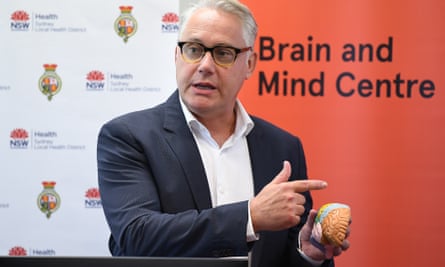Groundbreaking research into the long-term ramifications of concussion in sport has found chronic traumatic encephalopathy in the brains of more than half of a cohort of donors, including three under the age of 35.
The Australian Sports Brain Bank on Monday reported its preliminary findings after examining the 21 brains posthumously donated by sportspeople since the centre’s inception in 2018.
Of those – all of whom had played sports with risks of repetitive head injury, including 17 in football codes – 12 donors were found to have CTE lesions, while all but one exhibited some form of neurodegeneration.
CTE, which can only be definitively diagnosed at autopsy, is a neurodegenerative condition linked to repeated head traumas. Symptoms experienced during life include cognitive impairment, impulsive behaviour, depression, suicidal thoughts, short-term memory loss and emotional instability.
Among the group with CTE are the already-reported cases of high-profile Australian rules footballers Danny Frawley, Shane Tuck and Polly Farmer, along with two anonymous former professional rugby league players. Both Frawley and Tuck took their own lives, while Farmer had Alzheimer’s – another condition linked to head injuries.
But the additional findings made by Associate Professor Michael Buckland, a neuropathologist at the Royal Prince Alfred hospital and the University of Sydney, and his brain bank colleagues, underlined the prevalence and severity of traumatic brain injury across all age groups and levels of collision-based sport.
“CTE was identified in the brains of older former professionals with long playing careers, but also in younger, nonprofessional sportsmen and in recent professionals who had played under modern concussion guidelines,” wrote Buckland and his fellow researchers in the paper published by the Medical Journal of Australia.
“Three donors with CTE were under 35 years of age. Six of the 12 donors with CTE and one of nine without CTE had died by suicide, suggesting CTE may be a suicide risk factor.
“Screening for CTE in all deaths by suicide is probably impractical, but our finding suggests it should be undertaken if a history of repetitive head injury is known or suspected.”

The conversation around the link between concussion – and subclinical concussion – and irreversible brain injury have engulfed collision-based sports globally.
In Australia, class actions against the governing bodies of football codes in particular are attracting more and more present and former players, increasing the pressure on sporting institutions to act in a manner commensurate with this unfolding epidemic.
The less frequently reported victims are amateur athletes, whom this research has concluded are no less at risk than their professional counterparts.
The researchers acknowledged that “ascertainment bias for abnormal neuropathology was inevitable” given brain donations were motivated by either clinical diagnoses or the concerns of family members.
But they also stated it was “remarkable that CTE was found in more than half of these cases”.
“Moreover,” they wrote, “in half of the donor brains with CTE, it was the sole neurodegenerative pathology … our findings should encourage clinicians and policymakers to develop measures that further mitigate the risk of sport-related repetitive head injury.”
Since 2018 the brain has received more than 600 donation pledges from amateur and professional sportspeople.
